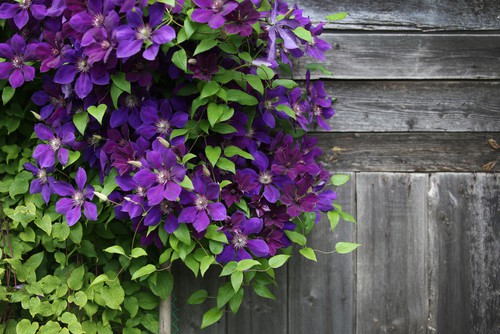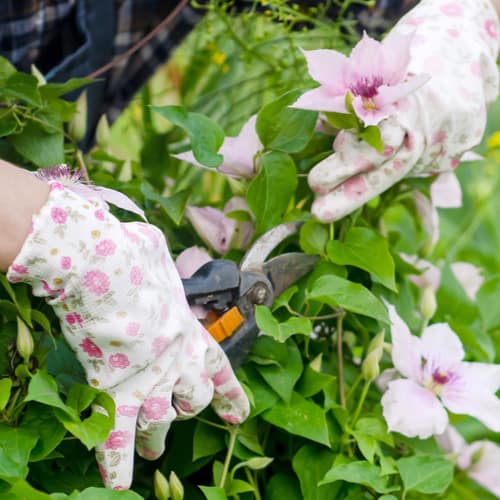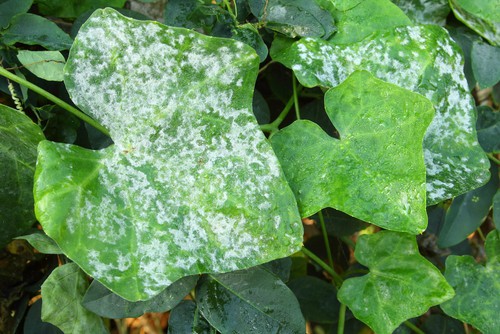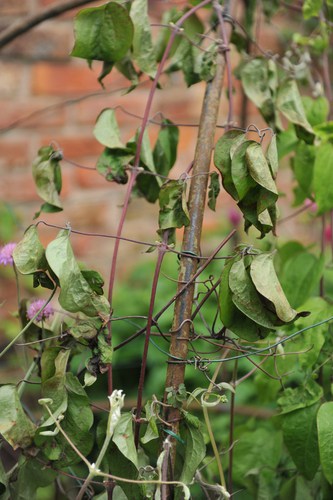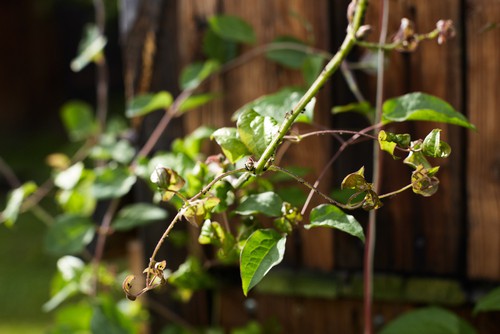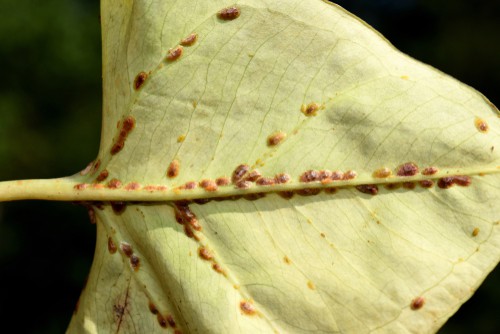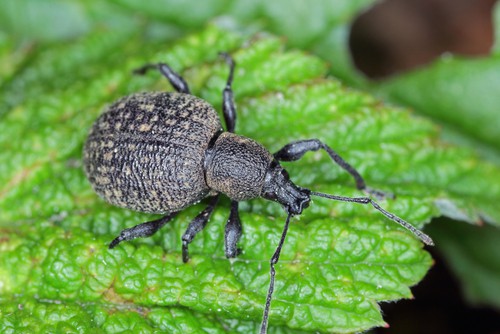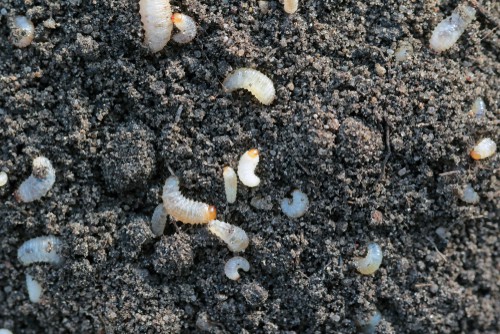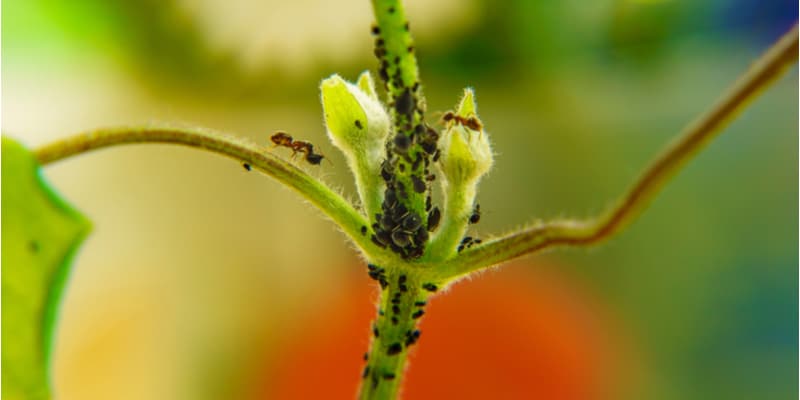
Clematis problems – Pest, diseases and other problems to look out for
Our site is reader supported, this means we may earn a small commission from Amazon and other affiliates when you buy through links on our site.
The Clematis is by far the most popular climbing plant and anyone who has grown clematis appreciates the spectacular beauty of their display when in full bloom. These low maintenance plants just need fertile, well-drained soil and plenty of sun to thrive.
For the most part, clematis can grow without any issues, but problems arise due to environmental factors, pests and diseases that attack the plant. However, most can be treated and sometimes even prevented.
Understanding some of the problems associated with clematis will help you grow healthy plants and diagnose different problems with ease. Dealing with pests or diseases early on can help to reduce the damage caused to your clematis.
The sections below reveal the most common pests and diseases, together with their possible treatments.
Environmental factors affecting Clematis
While clematis enjoys time in the sun, usually the more sun the better, too much heat can cause the plant to start wilting. The plant’s roots need to be kept cool, which is why you will often hear professional gardeners say that your clematis need cool roots, and the soil is kept moist to prevent the plant from losing too much water.
Mulching is also a good way of retaining moisture and shading the roots from the hot sun. On these especially hot days, water the plants at least daily to help the plant cope with the rising temperatures. If you are growing them in containers you can also add a layer of pebbles to the top of the soil to help retain the moisture more effectively and keep the roots cool. Also consider planting clematis in deep pots as this also helps.
In some rare cases, Clematis plants can also be affected by low temperatures. This makes the plants produce green petals. These green petals eventually deform thanks to the contagious phytoplasm that invades them. Because the disease is contagious remove any affected plants, especially those that keep producing green petals season after season.
Why are my clematis not flowering?
One of the most common problems (that are not related to pests or diseases) is when your clematis does not flower. This is a common problem, and as long as the clematis is in good condition, gets plenty of sun and is otherwise healthy, it is usually caused by incorrect pruning or pruning at the wrong time of year.
Some clematis’ flower on the previous year’s growth, so if you prune this off, then you will get no flowers the following season. Pruning clematis is fairly straightforward, but you need to know what group your clematis falls into. Basically, it will be pruning group 1, 2 or 3.
Once you know, then you will just need to prune them correctly depending on the pruning group.
Prune at the following times to prevent issues with non flowering clematis
- Pruning Group 1: Prune mid- to late spring, after flowering and once the risk of frost has passed. These types of clematis are early flowering and you do not need to prune to remove faded flowers.
- Pruning Group 2: Prune in February and after the first flush of flowers in early summer. These flower May-June so remove faded flowers only and then they will flower again in the summer.
- Pruning Group 3: Prune hard in February. This is the only clematis that needs pruning back to around 1-2ft above the ground, once a year.
Common diseases to watch out for on Clematis
Powdery mildew
Powdery mildew stems from a fungus that thrives on the upper surfaces of leaves. It is not too serious but plants will look unsightly. The infected leaves sport white powdery patches that prevent the foliage from absorbing light or air. If the leaves are unable to function properly, they start to discolour and finally fall off. The infection spreads because it is easy for the wind to dislodge the spores produced.
Tackle powdery mildew with copper sulphate fungicides or use organic methods like neem oil sprays. Regardless, it is better to catch the infection early to limit the damage done to the appearance of the plants. Remove badly affected leaves and spray with a fungicide.
Clematis wilt
Scientifically identified as Calophoma clematidina, clematis wilt is a fungal infection that affects clematis at a fast rate, however, the large-flowering hybrids and many of the species clematis are resistant to this disease. Clematis wilt is often blamed for wilting clematis but it’s often not the cause. It is more likely to be caused by slugs or snails eating the new foliage, honey fungus, root rot or vine weevil. All information on this you will find below.
However, if you do have clematis wilt, the disease will cause the stems to wilt and eventually lead to the demise of the plant. Clematis wilt attacks the plant causing lesions that affects the plant’s ability to transfer water and other nutrients. Usually, these lesions occur on stems close to the ground, therefore, cutting off the supply of water to the rest of the plant above.
This fungal infection is best being prevented rather than treated hence, plant clematis in well-drained soil and plant the clematis deeper than it was in its original pot. This has proved to help prevent clematis wilt as it ensures the clematis does not just lie on the ground, provides structural support to prevent fungi from the soil infecting the plant.
As for the affected plants, prune out the infected sections but sometimes, the worst-case scenario is that they need to be completely removed and destroyed.
Root rot
Root rot is a devastating disease brought about by different species of Phytophthora. It is more likely to be the cause of any new shoots wilting rather than clematis wilt. This infection stems from the soil and attacks the roots; therefore, affecting the plant’s ability to take in water and other vital nutrients.
Root rot thrives in waterlogged soils and that is why you are advised to plant a clematis in well-drained soils. The disease affects the younger roots first before spreading through the entire plant.
It is hard to mitigate this disease once it has been established, so it is best to take preventative measures. Give your clematis structural support by using trellises to get them off the ground. Additionally, prune your clematis often to increase the air circulation and get rid of any dead weight. Remove the infected plant and avoid growing new plants in that area for a while.
Honey fungus
Another disease taking a shot at your clematis is the honey fungus. This parasitic fungus invades the plant’s system preventing sap from getting to the rest of the clematis. By cutting off the sap supply, the rest of the plant dies off without nutrients. By the time, you notice stem dieback in your clematis, the infection has set in and it is hard to save the plant.
You’ll know it is honey fungus because the infected parts are blanketed by mycelium which gives off a mushroom-like smell. Dealing with honey fungus requires the removal of the infected plants as fungicides cannot help.
Read next: How to properly grow a clematis up a fence or wall
Pests that love clematis
Aphids
These small insects spend their lifetime attacking different plants, with greenflies being the most common. They attack most plants but love fresh the new growth on clematis. They do the most damage when in large populations as they suck the sap out of the plants and leave behind sticky honeydew, which in turn then attracts other insects to the plant. Affected foliage or blooms normally discolour and have a distorted appearance. Controlling the aphid population requires the use of horticultural oils, soapy water or natural predators such as parasitic wasps and even ladybirds. You can also spray them with pesticides.
Earwigs
Earwigs love chomping on clematis buds and leaves, leaving behind damaged flowers and leaves although it is not too serious and won’t kill the plant. These insects like to hide in the mulch around the base of the plant. They are usually not seen during the day, they do their damage at night. Use insecticidal soap or neem sprays to get rid of them.
Scale insects
Scales, similar to aphids deprive clematis of much-needed nutrients by feeding off the plant’s sap. Scales that produce honeydew set the perfect environment for the growth of sooty mould that continues to weaken the plant.
The consumption of the plant’s sap, together with the secretion of honeydew, prevent the leaves from functioning properly. You will notice the leaves start yellowing and stems distorting due to the damage.
Prune off the infected sections and apply insecticides, neem spray or horticultural oils. You can also use natural predators like lacewings.
Vine weevils eat the leaves while their grubs eat the roots
The most damage that adult vine weevils can do is chomp on the leaves in an irregular pattern. It’s not too serious and you can just watch out for them and dispose of them by hand.
The stage that vine weevils do the worst damage is when they are in the larvae phase (and this goes for all plants) and clematis grown in pots are at the highest risk because the roots are so confined. Vine weevils lay eggs in the soil and when the larvae emerge they begin eating the roots. Eating of the roots paralyses the plant’s nutrients and water transportation, eventually causing the plant to wilt.
The best way to deal with vine weevils is to let natural predators, such as birds, toads and nematodes reduce the population. However, for plants grown in pots, there are also vine weevil formulated insecticides that are very successful and you use them as a drench, applying it to the soil.
Got a shady area of the garden? why not look at my list of the best clematis for shade here
